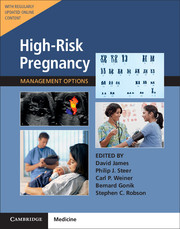Book contents
- Frontmatter
- Contents
- List of Contributors
- Preface
- Section 1 Prepregnancy Problems
- Section 2 Early Prenatal Problems
- Section 3 Late Prenatal – Fetal Problems
- 9 Prenatal Fetal Surveillance
- 10 Fetal Growth Disorders
- 11 Disorders of Amniotic Fluid
- 12 Fetal Hemolytic Disease
- 13 Fetal Thrombocytopenia
- 14 Fetal Cardiac Arrhythmias
- 15 Fetal Cardiac Abnormalities
- 16 Fetal Craniospinal and Facial Abnormalities
- 17 Fetal Genitourinary Abnormalities
- 18 Fetal Gastrointestinal and Abdominal Abnormalities
- 19 Fetal Skeletal Abnormalities
- 20 Fetal Tumors
- 21 Fetal Hydrops
- 22 Fetal Death
- Section 4 Problems Associated with Infection
- Section 5 Late Pregnancy – Maternal Problems
- Section 6 Late Prenatal – Obstetric Problems
- Section 7 Postnatal Problems
- Section 8 Normal Values
- Index
22 - Fetal Death
from Section 3 - Late Prenatal – Fetal Problems
- Frontmatter
- Contents
- List of Contributors
- Preface
- Section 1 Prepregnancy Problems
- Section 2 Early Prenatal Problems
- Section 3 Late Prenatal – Fetal Problems
- 9 Prenatal Fetal Surveillance
- 10 Fetal Growth Disorders
- 11 Disorders of Amniotic Fluid
- 12 Fetal Hemolytic Disease
- 13 Fetal Thrombocytopenia
- 14 Fetal Cardiac Arrhythmias
- 15 Fetal Cardiac Abnormalities
- 16 Fetal Craniospinal and Facial Abnormalities
- 17 Fetal Genitourinary Abnormalities
- 18 Fetal Gastrointestinal and Abdominal Abnormalities
- 19 Fetal Skeletal Abnormalities
- 20 Fetal Tumors
- 21 Fetal Hydrops
- 22 Fetal Death
- Section 4 Problems Associated with Infection
- Section 5 Late Pregnancy – Maternal Problems
- Section 6 Late Prenatal – Obstetric Problems
- Section 7 Postnatal Problems
- Section 8 Normal Values
- Index
Summary
Definitions of Stillbirth
The US National Center for Health Statistics (NCHS) defines fetal death as “death prior to the complete expulsion or extraction from the mother of a product of human conception, irrespective of the duration of pregnancy and which is not an induced termination of pregnancy.” This definition is subcategorized by the gestational age at which the demise occurred: embryonic death at ≥ 12+6 weeks, early fetal death at 13–19+6 weeks’ gestation, intermediate fetal death at 20–27+6 weeks’ gestation, and late fetal death at ≥28 weeks’ gestation. The NCHS recommends reporting fetal deaths at ≥20 weeks’ gestation or, should the gestational age be unknown, a fetal weight of ≥ 350 grams, which represents the 50th percentile of weight at 20 weeks. Excluded from the definition of fetal death and associated statistics are losses due to induction after previable premature rupture of membranes or terminations/inductions for lethal fetal anomalies.
Though many terms have come to represent fetal death among parent groups, researchers, and medical professionals, stillbirth is widely accepted among lay populations, and has been adopted by the American College of Obstetricians and Gynecologists (ACOG) and research groups to define fetal deaths ≥ 20 weeks’ gestation.
Other countries may use definitions and categorizations that are slightly different to these.
Epidemiology
Worldwide, stillbirth at ≥ 28 weeks’ gestation complicates approximately 3.2 million pregnancies annually, with 98% occurring in low- and middle-income countries. India, Pakistan, China, Nigeria, and Bangladesh have the five highest rates of stillbirth. In the US, an estimated 26,000 stillbirths occur annually, or one in 160 pregnancies. The overall stillbirth rate in the US was unchanged between 2006 and 2012: 6.05 per 1000 births. The early stillbirth rate per 1000 births (20–27 weeks) in 2006 (3.10 per 1000 births) and 2012 (3.11 per 1000 births) as well as the late stillbirth rate (≥ 28 weeks) (2.96 per 1000 births in 2012 and 2.97 per 1000 births in 2006) were each unchanged. Compared to other developed countries, the stillbirth rate in the United States is among the highest.
- Type
- Chapter
- Information
- High-Risk Pregnancy: Management OptionsFive-Year Institutional Subscription with Online Updates, pp. 568 - 578Publisher: Cambridge University PressFirst published in: 2017



